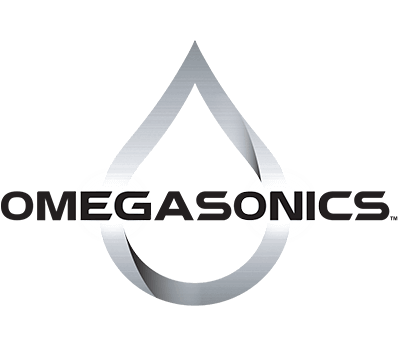Since the development of ultrasonic cleaning systems, only two types of ultrasonic transducers have ever been used to generate the sound waves required for cavitation—piezoelectric and magnetostrictive.
Both work effectively, however each has some pluses and minuses; as a result, designers over the years have debated which type is preferable for use in an ultrasonic cleaner.
Piezoelectric and magnetostrictive transducers are used to generate sound waves in ultrasonic cleaning systems. Omegasonics compares each type of ultrasonic transducer.
We’re going to look at how each type of ultrasonic transducer works, the pros and cons of each type, and then let you decide which type would best suit your needs.
How Each Ultrasonic Transducer Works
The two types of ultrasonic transducers work in completely different ways to achieve the same result. In piezoelectric transducers, a crystal with special electrical properties (originally it was quartz, today it’s a modern ceramic called lead zirconate titanate) is connected with electrical wires attached to opposite faces of the crystal.
The crystal and wires are housed between two metal plates. When voltage is passed through the crystal, it changes shape. When the electricity is taken away, it returns to its original shape. And when there’s no voltage at a given frequency, the crystal and the metal housing around it will resonate.
Magnetostrictive transducers work on the principle that iron-rich metals (originally it was iron and steel, today it’s Terfenol-D) expand and contract when they are placed in a magnetic field. To make a magnetostrictive transducer, many thin plates of this material are stacked up side by side to make a “core.” Copper wire is then wrapped cylindrically around the core, and the whole assembly is placed in a canister, with the top and bottom plates of the canister touching the ends of the core.
Since electricity produces a magnetic field, as soon as current is applied to the copper coil, the core grows in length. When the current is turned off, the core returns to its original shape. By using an alternating current source to power the transducer, it expands and contracts, causing the canister in which it’s housed to resonate.
Pros and Cons Related to Ultrasonic Cleaning
Method of Attachment – Piezoelectric transducers are attached to an ultrasonic cleaner housing using an adhesive, while magnetostrictive transducers are usually attached by welding the housing to the tank. Early on, magnetostrictive transducers had an advantage in this area, because the adhesives available were not very strong, and piezoelectric transducers would become detached. Today, however, with the advent of modern engineered adhesives developed for aircraft, the difference is negligible.
Transducer Frequency – For most parts and contaminants, ultrasonic cleaning is best done between 40 and 70 kHz, although some ultrasonic cleaners use frequencies as low as 25 kHz and as high as 170 kHz or higher. The highest reasonable frequency achievable in a magnetostrictive transducer is around 30 kHz, because in order to change the resonant frequency, the core must be made shorter and shorter, and the system eventually reaches such a low mass that no transmittal of the vibration occurs to the tank.
Piezoelectric transducers are not limited by this restriction, and can therefore accommodate the entire frequency range. Because of this, magnetostrictive transducers are usually limited to low frequency ultrasonic cleaning applications where the parts are large and contaminants are difficult to remove, but complete cleaning is not required.
Energy Consumption – Piezoelectric transducers convert low voltage electrical energy into mechanical energy in one step, making them very efficient. Magnetostrictive transducers convert electrical energy into magnetic energy, and then to mechanical energy. A lot of energy is lost in the form of heat during this process, and as a result, these transducers are less efficient. That means for equal amounts of ultrasonic cleaning, piezoelectric transducers will consume much less power
Inherent Noise Level – Since most piezoelectric transducers operate at 40 kHz and above, the first sub-harmonic frequency is above 20 kHz, which is beyond the range a human can hear. Magnetostrictive transducers operate at 30 kHz or less, which puts the first sub-harmonic in the audible range for humans (20 Hz to 20 kHz). The sound is identical to the hum emitted from a high-tension electrical line or transformer. When multiple magnetostrictive transducers are mounted to the same ultrasonic cleaner tank, the noise level is such that hearing protection is usually required.
Life Expectancy – When piezoelectric transducers were first designed (using quartz crystals), their strength would drop off over a period of time. Magnetostrictive transducers had no such issues, and as a result were the transducer of choice for a long time in ultrasonic cleaning systems. Later, as engineers began to develop the semiconductor ceramic materials used in piezoelectric transducers, they learned that “aging” the material before converting it to piezoelectric wafers eliminated 99 percent of the strength degradation. Because of this practice, piezoelectric transducers do not lose effectiveness with age like they once did, and magnetostrictive transducers lost their biggest advantage.
